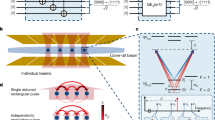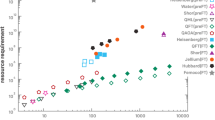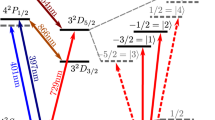Abstract
Generating quantum entanglement in large systems on timescales much shorter than the coherence time is key to powerful quantum simulation and computation. Trapped ions are among the most accurately controlled and best isolated quantum systems1 with low-error entanglement gates operated within tens of microseconds using the vibrational motion of few-ion crystals2,3. To exceed the level of complexity tractable by classical computers the main challenge is to realize fast entanglement operations in crystals made up of many ions (large ion crystals)4. The strong dipole–dipole interactions in polar molecule5 and Rydberg atom6,7 systems allow much faster entangling gates, yet stable state-independent confinement comparable with trapped ions needs to be demonstrated in these systems8. Here we combine the benefits of these approaches: we report a two-ion entangling gate with 700-nanosecond gate time that uses the strong dipolar interaction between trapped Rydberg ions, which we use to produce a Bell state with 78 per cent fidelity. The sources of gate error are identified and a total error of less than 0.2 per cent is predicted for experimentally achievable parameters. Furthermore, we predict that residual coupling to motional modes contributes an approximate gate error of 10−4 in a large ion crystal of 100 ions. This provides a way to speed up and scale up trapped-ion quantum computers and simulators substantially.
This is a preview of subscription content, access via your institution
Access options
Access Nature and 54 other Nature Portfolio journals
Get Nature+, our best-value online-access subscription
$29.99 / 30 days
cancel any time
Subscribe to this journal
Receive 51 print issues and online access
$199.00 per year
only $3.90 per issue
Buy this article
- Purchase on Springer Link
- Instant access to full article PDF
Prices may be subject to local taxes which are calculated during checkout




Similar content being viewed by others
Data availability
The datasets generated during and analysed during the current study are available from the corresponding authors on reasonable request.
References
Wineland, D. J. et al. Experimental issues in coherent quantum-state manipulation of trapped atomic ions. J. Res. Natl. Inst. Stand. Technol. 103, 259 (1998).
Ballance, C. J. et al. High-fidelity quantum logic gates using trapped-ion hyperfine qubits. Phys. Rev. Lett. 117, 060504 (2016).
Gaebler, J. P. et al. High-fidelity universal gate set for 9Be+ ion qubits. Phys. Rev. Lett. 117, 060505 (2016).
Hempel, C. et al. Quantum chemistry calculations on a trapped-ion quantum simulator. Phys. Rev. X 8, 031022 (2018).
Anderegg, L. et al. Laser cooling of optically trapped molecules. Nat. Phys. 14, 890–893 (2018).
Wilk, T. et al. Entanglement of two individual neutral atoms using Rydberg blockade. Phys. Rev. Lett. 104, 010502 (2010).
Isenhower, L. et al. Demonstration of a neutral atom controlled-NOT quantum gate. Phys. Rev. Lett. 104, 010503 (2010).
Saffman, M. Quantum computing with atomic qubits and Rydberg interactions: progress and challenges. J. Phys. B 49, 202001 (2016).
Wang, Y. et al. Single-qubit quantum memory exceeding ten-minute coherence time. Nat. Photon. 11, 646–650 (2017).
Chiaverini, J. et al. Realization of quantum error correction. Nature 432, 602–605 (2004).
Schindler, P. et al. Experimental repetitive quantum error correction. Science 332, 1059–1061 (2011).
Wong-Campos, J. D. et al. Demonstration of two-atom entanglement with ultrafast optical pulses. Phys. Rev. Lett. 119, 230501 (2017).
Schäfer, V. M. et al. Fast quantum logic gates with trapped-ion qubits. Nature 555, 75–78 (2018).
Levine, H. et al. Parallel implementation of high-fidelity multiqubit gates with neutral atoms. Phys. Rev. Lett. 123, 170503 (2019).
Graham, T. M. et al. Rydberg mediated entanglement in a two-dimensional neutral atom qubit array. Phys. Rev. Lett. 123, 230501 (2019).
Zhang, S., Robicheaux, F. & Saffman, M. Magic-wavelength optical traps for Rydberg atoms. Phys. Rev. A 84, 043408 (2011).
Savard, T. A., O’Hara, K. M. & Thomas, J. E. Laser-noise-induced heating in far-off resonance optical traps. Phys. Rev. A 56, R1095 (1997).
Belyansky, R. et al. Nondestructive cooling of an atomic quantum register via state-insensitive Rydberg interactions. Phys. Rev. Lett. 123, 213603 (2019).
Devoret, M. H. & Schoelkopf, R. J. Superconducting circuits for quantum information: an outlook. Science 339, 1169–1174 (2013).
Veldhorst, M. et al. A two-qubit logic gate in silicon. Nature 526, 410–414 (2015).
Müller, M. et al. Trapped Rydberg ions: from spin chains to fast quantum gates. New J. Phys. 10, 093009 (2008).
Feldker, T. et al. Rydberg excitation of a single trapped ion. Phys. Rev. Lett. 115, 173001 (2015).
Higgins, G. et al. Single strontium Rydberg ion confined in a Paul trap. Phys. Rev. X 7, 021038 (2017).
Higgins, G. et al. Coherent control of a single trapped Rydberg ion. Phys. Rev. Lett. 119, 220501 (2017).
Saffman, M., Walker, T. G. & Mølmer, K. Quantum information with Rydberg atoms. Rev. Mod. Phys. 82, 2313 (2010).
Li, W. & Lesanovsky, I. Entangling quantum gate in trapped ions via Rydberg blockade. Appl. Phys. B 114, 37–44 (2014).
Urban, E. et al. Observation of Rydberg blockade between two atoms. Nat. Phys. 5, 110–114 (2009).
Gaëtan, A. et al. Observation of collective excitation of two individual atoms in the Rydberg blockade regime. Nat. Phys. 5, 115–118 (2009).
Rao, D. D. B. & Mølmer, K. Robust Rydberg-interaction gates with adiabatic passage. Phys. Rev. A 89, 030301 (2014).
Leibfried, D. et al. Creation of a six-atom ‘Schrödinger cat’ state. Nature 438, 639–642 (2005).
Higgins, G., Pokorny, F., Zhang, C. & Hennrich, M. Highly polarizable Rydberg ion in a Paul trap. Phys. Rev. Lett. 123, 153602 (2019).
Barrett, M. D. et al. Sympathetic cooling of 9Ba+ and 24Mg+ for quantum logic. Phys. Rev. A 68, 042302 (2003).
Tan, T. R. et al. Multi-element logic gates for trapped-ion qubits. Nature 528, 380–383 (2015).
Kielpinski, D., Monroe, C. & Wineland, D. J. Architecture for a large-scale ion-trap quantum computer. Nature 417, 709 (2002).
Gambetta, F. M., Li, W., Schmidt-Kaler, F. & Lesanovsky, I. Engineering non-binary Rydberg interactions via electron-phonon coupling. Phys. Rev. Lett. 124, 043402 (2020).
Wüster, S. & Rost, J.-M. Rydberg aggregates. J. Phys. B 51, 032001 (2018).
Acknowledgements
We thank K. Mølmer for discussions and suggestions for the gate scheme. We thank all members of the ERyQSenS consortium for discussions. This work was supported by the European Research Council under the European Unions Seventh Framework Programme/ERC grant agreement number 279508, the Swedish Research Council (Trapped Rydberg Ion Quantum Simulator), the QuantERA ERA-NET Cofund in Quantum Technologies (ERyQSenS), and the Knut & Alice Wallenberg Foundation (Photonic Quantum Information). I.L. and W.L. acknowledge support from the EPSRC through grant number EP/M014266/1 and grant number EP/R04340X/1 via the QuantERA project ERyQSenS. I.L. also gratefully acknowledges funding through the Royal Society Wolfson Research Merit Award.
Author information
Authors and Affiliations
Contributions
G.H., F.P. and M.H. built the experimental system. C.Z. and F.P. set up the microwave dressing and improved the ultraviolet laser system. A.P. set up ablation loading of ions and the camera software. C.Z. had the idea of combining microwave dressing and STIRAP excitation. C.Z. and G.H. carried out the measurements. C.Z. analysed the data. C.Z. and W.L. simulated the results. M.H. designed and administered the experiment, W.L. and I.L. calculated properties of atomic Rydberg states. W.L., I.L. and C.Z. analysed the scaling of the gate error. All authors contributed to discussions and the writing of the manuscript.
Corresponding authors
Ethics declarations
Competing interests
The authors declare no competing interests.
Additional information
Peer review information Nature thanks Kihwan Kim, Peter Maunz and the other, anonymous, reviewer(s) for their contribution to the peer review of this work.
Publisher’s note Springer Nature remains neutral with regard to jurisdictional claims in published maps and institutional affiliations.
Supplementary information
Supplementary Information
This file contains Supplementary Sections 1-5, including Supplementary Figures 1-3, Supplementary Table 1 and Supplementary References.
Rights and permissions
About this article
Cite this article
Zhang, C., Pokorny, F., Li, W. et al. Submicrosecond entangling gate between trapped ions via Rydberg interaction. Nature 580, 345–349 (2020). https://doi.org/10.1038/s41586-020-2152-9
Received:
Accepted:
Published:
Issue Date:
DOI: https://doi.org/10.1038/s41586-020-2152-9
This article is cited by
-
Ultrafast energy exchange between two single Rydberg atoms on a nanosecond timescale
Nature Photonics (2022)
-
Fast spin squeezing by distance-selective long-range interactions with Rydberg molecule dressing
Science China Physics, Mechanics & Astronomy (2022)
-
Rydberg quantum computation with nuclear spins in two-electron neutral atoms
Frontiers of Physics (2021)
-
Aspects of quantum states asymmetry for the magnetic dipolar interaction dynamics
Quantum Information Processing (2021)
Comments
By submitting a comment you agree to abide by our Terms and Community Guidelines. If you find something abusive or that does not comply with our terms or guidelines please flag it as inappropriate.



